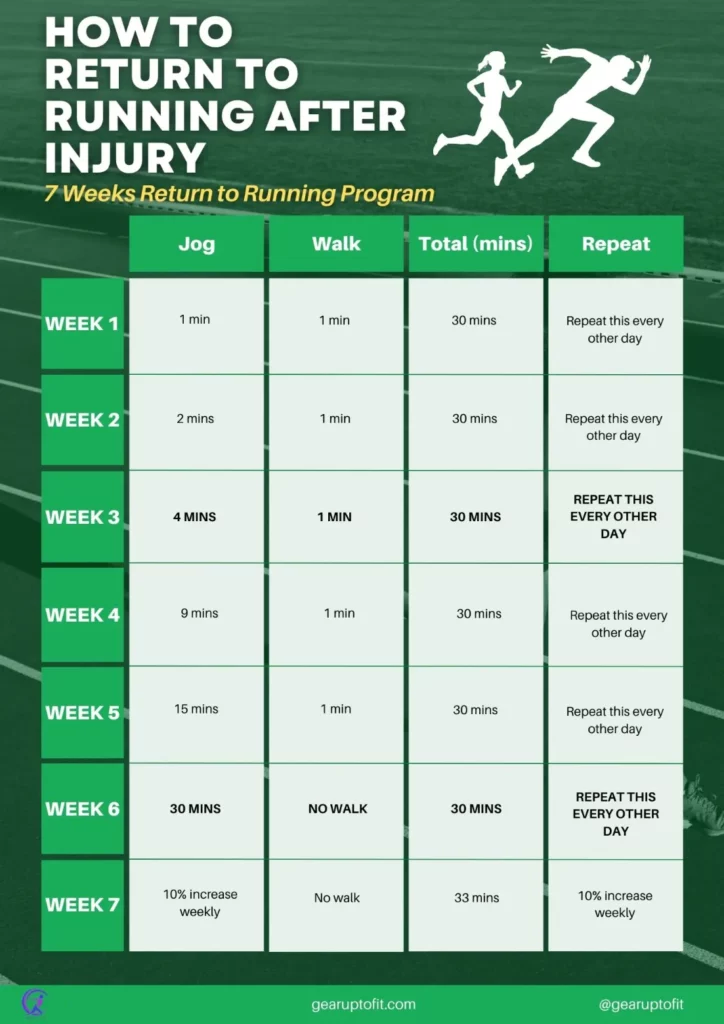Getting back to running after an injury feels like standing at the edge of a cliff—you know you need to jump, but your body whispers warnings about what happened last time. I’ve been there. That sharp pain that stops you mid-stride, the weeks of watching other runners glide past your window while you ice your knee. The frustration tastes bitter, like old coffee.
Here’s the truth: returning to running after injury isn’t about being tough. It’s about being smart. Your body needs a roadmap back to the pavement, not a sprint to the finish line.
Key Takeaways
- Start with walk-run intervals — alternate between walking and running to gradually rebuild your running tolerance
- Follow the 10% rule — increase weekly mileage by no more than 10% to prevent re-injury
- Listen to pain signals — if pain appears during or after runs, reduce duration or add more rest days
- Get professional guidance — work with a physical therapist or running specialist for personalized recovery plans
- Build strength first — address muscle weaknesses through targeted exercises before increasing running volume
- Aim for 80% confidence — don’t progress until you feel mentally and physically ready for the next level
Understanding the Return-to-Running Process

Running injuries are sneaky creatures. Unlike a sudden ankle twist, most running injuries creep up slowly—a whisper that becomes a scream. That’s why recovery needs the same patience. You can’t rush healing any more than you can rush a good whiskey.
The biggest mistake I see? Runners treating their return like a light switch—off one day, fully on the next. Your muscles, tendons, and bones don’t work that way. They need time to remember their job, to rebuild their strength fiber by fiber.
Think about it: major muscle groups in your legs absorb anywhere from 1.5 to 8 times your body weight with each step. That’s like catching a falling refrigerator thousands of times during a single run. After injury, those muscles need to relearn this superhuman feat gradually.
Return to Running After Injury
Your personalized roadmap to safe and effective recovery
Rest & Recovery
Allow your body to heal properly with adequate rest and rehabilitation exercises.
Walk Before You Run
Start with walking programs to rebuild base fitness and test injury recovery.
Run/Walk Intervals
Gradually introduce running with structured walk-run intervals.
Progressive Running
Slowly increase running duration and intensity while monitoring your body.
Your Recovery Timeline
Week 1-2: Initial Recovery
Focus on rest, ice, compression, and elevation. Consult with healthcare professionals and begin gentle mobility exercises as approved.
Week 3-4: Active Recovery
Start with 20-30 minute walks at a comfortable pace. Include strength training for supporting muscles and continue physical therapy.
Week 5-6: Return to Running
Begin with 1-minute run / 2-minute walk intervals. Gradually increase running time while decreasing walking intervals.
Week 7+: Building Back
Progress to continuous running sessions. Follow the 10% rule - don't increase weekly mileage by more than 10% each week.
Essential Recovery Tips
Listen to Your Body
Proper Warm-Up & Cool-Down
Strength Training is Key
Nutrition & Hydration
Calculate Your Return Timeline
Get a personalized estimate based on your injury and fitness level
Your Personalized Timeline
Ready to Start Your Recovery Journey?
Get the complete guide with detailed training plans and expert advice
Read Full GuideThe Psychology of Coming Back
Nobody talks about the mental game enough. That first run after injury feels like wearing someone else’s legs. Your brain remembers flying down the trail, but your body moves like it’s stuck in molasses. The confidence you once had? It’s hiding somewhere with your pre-injury pace.
This mental hurdle is real. Studies show that confidence levels need to hit about 80% before safely progressing in your return. That’s not just a nice number—it’s your brain’s way of saying “I trust this body again.”
I remember my first run back after a stress fracture. Three months off. I lasted eight minutes before walking home, not from pain but from fear. Every footfall felt like a question mark. Would this be the step that breaks me again?
Creating Your Return-to-Running Plan

Week 1-2: The Foundation Phase
Start with what feels insulting—walking. I know, I know. You’re a runner. But walking is your body’s way of remembering the motion without the impact. Add proper breathing techniques during these walks to prepare your cardiovascular system.
Begin with 20-30 minute walks every other day. On the off days, focus on strength training exercises that target your weak spots. If you had an Achilles injury, that means calf raises. Runner’s knee? Hello, quad strengthening.
Week 3-4: The Walk-Run Introduction
Here’s where it gets interesting. Start with a 20-minute session:
- 5 minutes walking warm-up
- 1 minute easy running, 2 minutes walking (repeat 4 times)
- 5 minutes walking cool-down
This feels too easy? Good. It should. Your ego wants to run faster, longer, harder. Tell it to shut up and wait.
Week 5-8: Building Volume
Now you can start feeling like a runner again. Gradually increase your running intervals while decreasing walking time. A sample progression:
- Week 5: Run 2 minutes, walk 1 minute
- Week 6: Run 3 minutes, walk 1 minute
- Week 7: Run 5 minutes, walk 1 minute
- Week 8: Run 10 minutes, walk 2 minutes
Remember to incorporate proper recovery methods between sessions. Your body rebuilds during rest, not during runs.
Common Return-to-Running Mistakes
Ignoring Pain Signals
Pain after running isn’t a badge of honor—it’s a warning label. If you feel pain during or after your run, you’ve got three options:
- Decrease the duration of your next run
- Add more rest days between runs
- Split your run into two shorter sessions (morning and evening)
Your body speaks in sensations. Learn its language.
Skipping Strength Work
Running isn’t just about running. It’s about having the strength to handle the impact. Many runners returning from injury skip the strength training component, thinking running alone will rebuild their fitness. Wrong.
Focus on:
- Single-leg exercises (Bulgarian split squats, single-leg deadlifts)
- Core stability work
- Hip strengthening movements
- Calf raises and toe walks
Comparing to Pre-Injury Fitness
Your pre-injury self is gone. Mourn it, then move on. Comparing your current pace to your PR is like comparing a seedling to an oak tree. Give yourself time to grow back stronger.
Specific Injury Considerations
Achilles and Calf Injuries
If you’re a forefoot striker, pay extra attention here. Your running style puts more stress on these areas. Start with:
- Eccentric calf raises (slow lowering phase)
- Gentle stretching only after warming up
- Consider trail running on softer surfaces initially
Knee and IT Band Issues
Overstriders, this one’s for you. Your running form might have contributed to your injury. Work on:
- Shortening your stride
- Landing with your foot under your center of mass
- Strengthening your glutes and hips
- Adding mobility training to your routine
Plantar Fasciitis
The dreaded foot pain that greets you every morning. Recovery requires patience and specific attention to:
- Foot strengthening exercises
- Proper footwear (consider getting fitted at a specialty running store)
- Gradual loading of the plantar fascia
- Stretching routines focusing on calves and feet
Building Mental Confidence

Physical readiness is only half the equation. Mental readiness determines whether you’ll stick with your comeback or quit after a bad day.
Visualization Techniques
Spend 5 minutes daily visualizing successful, pain-free runs. See yourself moving smoothly, breathing easily, finishing strong. Your brain doesn’t know the difference between imagined and real experience—use this to your advantage.
Setting Process Goals
Instead of focusing on pace or distance, set process goals:
- Complete all planned walk-run sessions this week
- Perform strength exercises 3 times
- Practice one mindfulness session after each run
Finding Support
Running alone after injury can feel isolating. Consider:
- Joining a beginner’s running group (swallow your pride)
- Finding a running buddy who understands your situation
- Working with a coach who specializes in injury recovery
- Connecting with online communities of runners returning from injury
Nutrition for Recovery
Your body needs fuel to rebuild. This isn’t the time for restrictive dieting. Focus on:
- Protein: Aim for 1.2-1.6g per kg of body weight to support tissue repair
- Carbohydrates: Don’t fear them—they fuel your runs and recovery
- Anti-inflammatory foods: Add superfoods like berries, fatty fish, and leafy greens
- Hydration: Increase water intake to support healing processes
Consider adding high-protein snacks between meals to support muscle recovery.
Monitoring Progress

Track these markers weekly:
- Pain levels (0-10 scale) during and after runs
- Energy levels throughout the day
- Sleep quality
- Confidence level (aim for that 80% threshold)
- Running volume (time, not distance initially)
When to Seek Help
Some signs you need professional guidance:
- Pain that persists or worsens despite rest
- Swelling that doesn’t respond to ice and elevation
- Compensation patterns (limping, altered gait)
- Lack of progress after 4-6 weeks
- Recurring injuries in the same area
A physical therapist who specializes in running can analyze your gait, identify weaknesses, and create a personalized plan. This isn’t admitting defeat—it’s investing in your running future.
Long-Term Injury Prevention
Once you’re back to regular running, don’t forget what got you here. Implement these strategies:
Regular Strength Training
Continue strength work 2-3 times weekly, focusing on:
- Full-body workouts
- Single-leg stability
- Core strength
- Hip mobility
Smart Training Progression
Follow these principles:
- Increase weekly mileage by no more than 10%
- Include one complete rest day weekly
- Vary your running surfaces
- Incorporate cross-training activities
Listen to Your Body
Early warning signs to respect:
- Persistent fatigue
- Declining performance
- Mood changes
- Sleep disruption
- Minor aches that don’t resolve with rest
The Reality Check
Returning to running after injury isn’t a straight line. Some days you’ll feel invincible. Others, you’ll wonder if you’ll ever run pain-free again. Both are normal. Both are temporary.
I’ve watched runners come back from injuries that seemed career-ending. The difference between those who succeed and those who don’t? Patience. Smart progression. And the wisdom to know that coming back slowly means coming back for good.
Your injury taught you something. Maybe it was about training too hard, ignoring warning signs, or skimping on strength work. Use that knowledge. Let it make you a smarter, stronger runner.
Final Thoughts
The road back to running isn’t just about healing tissue—it’s about rebuilding trust with your body. Every careful step, every patient week, every small victory adds up to something bigger: a sustainable return to the sport you love.
Remember, you’re not just returning to running. You’re returning as a different runner—one who understands their body better, respects its limits, and knows how to build back stronger.
Take it one day at a time. Trust the process. And soon enough, you’ll find yourself flying down that trail again, grateful for every pain-free step.
Your comeback starts with a single step. Make it count.
References
- https://www.jospt.org/doi/10.2519/jospt.2020.9575
- https://bjsm.bmj.com/content/49/5/278
- https://www.ncbi.nlm.nih.gov/pmc/articles/PMC6797957/
- https://journals.sagepub.com/doi/10.1177/0363546519852389
- https://www.sciencedirect.com/science/article/pii/S2095254618301005
As a veteran fitness technology innovator and the founder of GearUpToFit.com, Alex Papaioannou stands at the intersection of health science and artificial intelligence. With over a decade of specialized experience in digital wellness solutions, he’s transforming how people approach their fitness journey through data-driven methodologies.